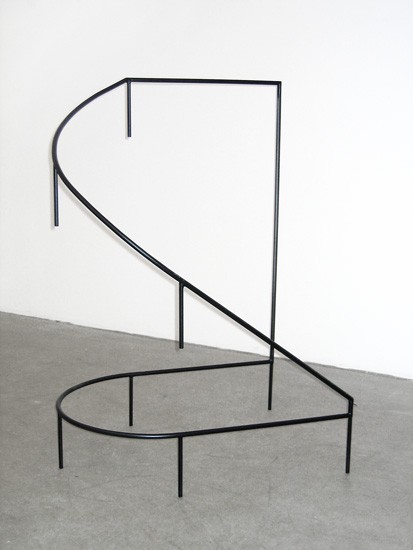II.
 The Easy Isn’t Done Easy (2007), lacquered steel, 100 x 70 x 50.5 cm.
The Easy Isn’t Done Easy (2007), lacquered steel, 100 x 70 x 50.5 cm.ART iT: It’s difficult to put the experience of your works into words. Certainly there is a technical vocabulary to do so, but it would seem almost absurdly technical when applied to the sheer elementality of the situations that you create, and the encounters between material, form and physics that occur in the works, or the way that the lines blur between support and display object and environment. Quite a few of your works resemble characters from some kind of alphabet, and seem to equally combine the same degree of arbitrariness and significance that symbols do.
TD: Many of the works have concrete sources. For example there is a drawing by Le Corbusier, a bisection of the golden ratio of Notre Dame with two half-circles intersecting. I was fascinated by this figure of Notre Dame’s golden ratio cut in half, so I made it into a sculpture. It’s not like I thought up the form myself or arrived at it through movement.
There are a number of works that come from architecture. There’s a piece based on an architectural void, like an alcove. I turned the void into a solid, reversing the negative space. This piece I first used as a plinth, then I made it in different sizes, and now it also stands by itself as its own sculpture. This shape also appears in the drawings that I made for the installation Time Future Contained in Time Past (2008). So in making numerous variations, it became part of my own language. In that sense even though it has a very concrete origin it almost came out of nowhere. I was looking at the architectural object, and the shape just appeared when I saw the negative space.
Sometimes I see something familiar that resonates with my sensibility, and then I am overcome by this urgency to use it for myself.
ART iT: In addition to the idea of variations of form, many of your works have a kind of torqued aspect, as though they have been twisted on their axes at some point in the process.
TD: I am always experimenting with impossibility: is it still possible? Is it still possible for this to stand, to defy gravity? Is it still possible to be a sculpture, or a body at the same time? Sometimes something makes me uncomfortable and has to be changed, and it has to be changed in an impossible way. Maybe I am attracted even to people who are a bit twisted. I don’t have answers to this.
But I don’t think I’m doing forms. I am working with movements. I work with materiality or energy – it’s a strange word, I always hesitate to use it.
Thea Djordjadze: The Secret Border in Human Closeness
